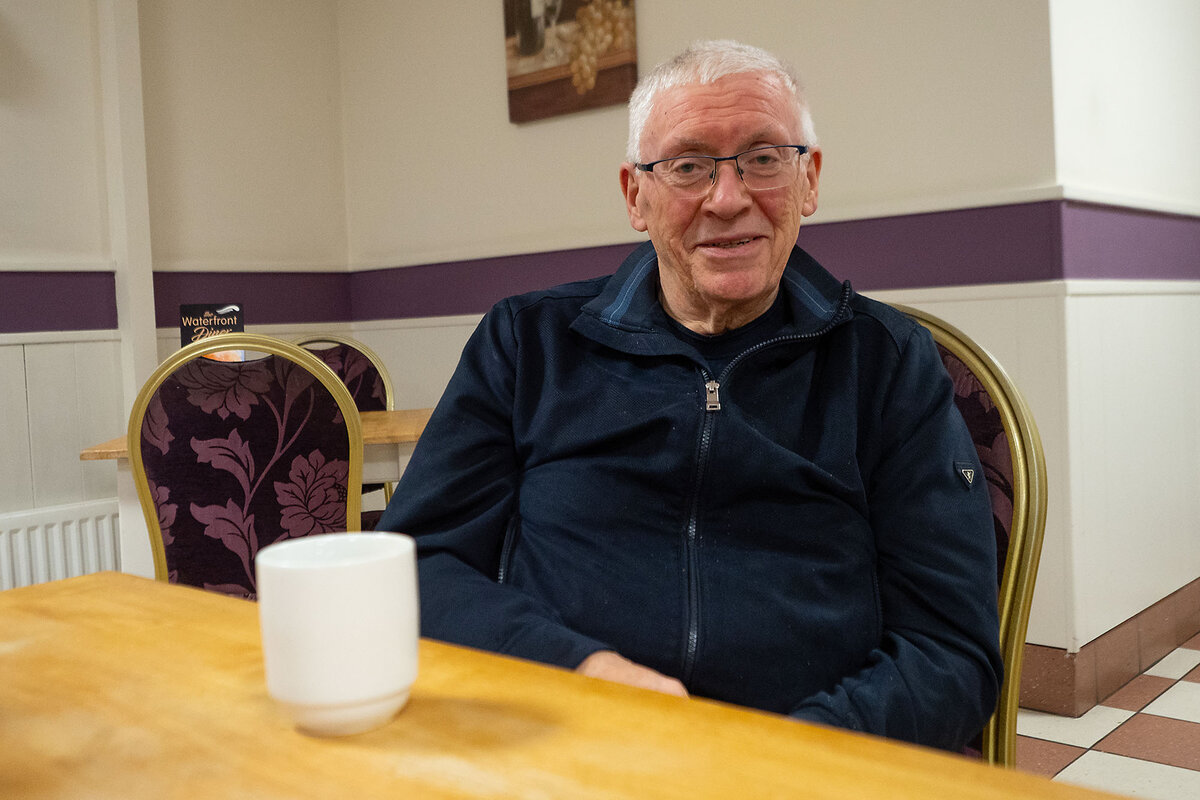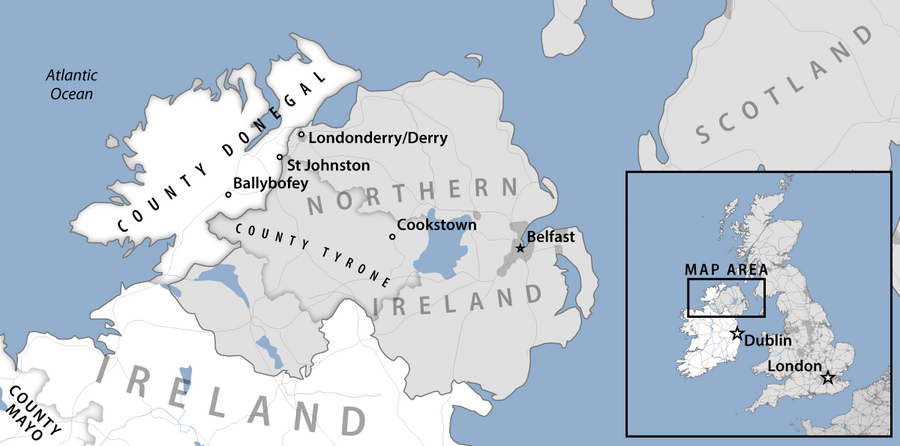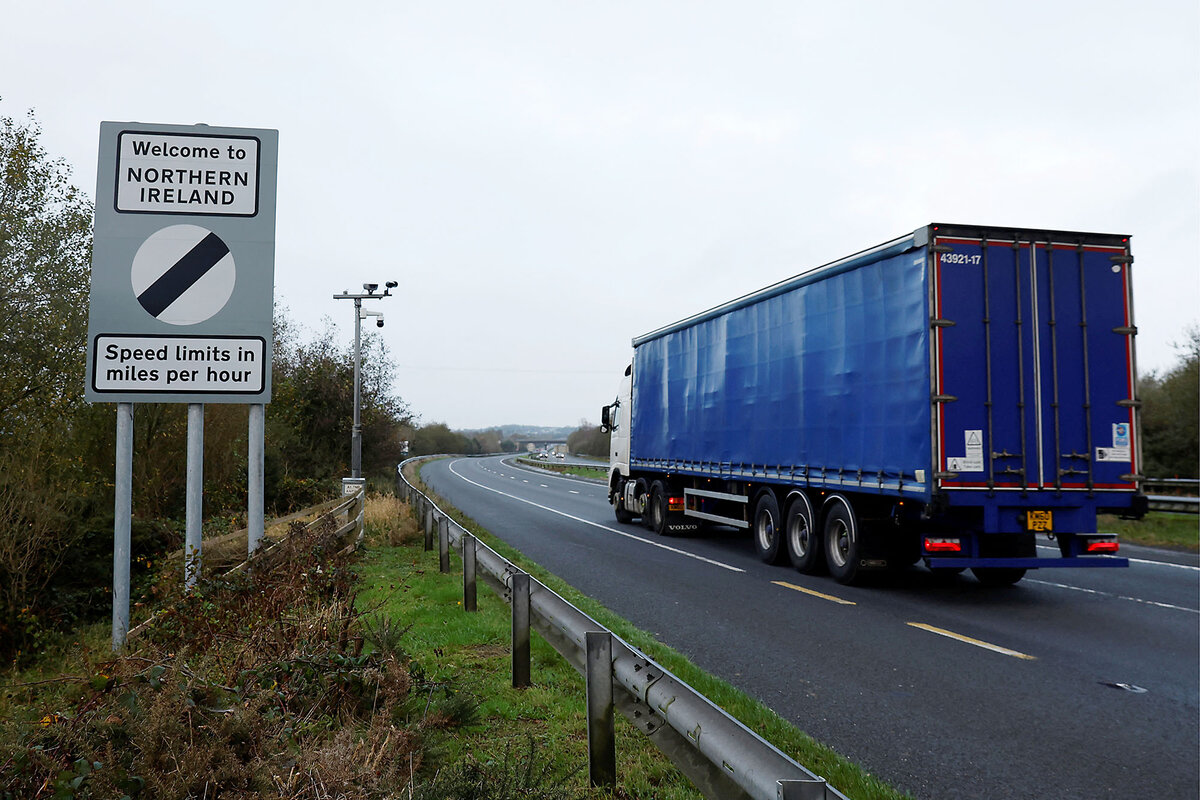One Ireland? In the south, the tide turns toward reunification.
Loading...
| St Johnston, Ireland
At a roadside diner in this small village in the far northwest of the Republic of Ireland, Kieran Harrigan contemplates a border that once loomed large but now seems barely to exist.
“The only way you know you’ve crossed the border is the color of the road markings,” says Mr. Harrigan, a retired construction manager, who has watched the frontier fade from identity flashpoint to negligible line.
It has been more than a century since the British government broke off six of Ireland’s 32 counties into Northern Ireland within the United Kingdom, with the remaining counties eventually becoming the independent Irish Republic. Partition sparked sectarian strife in Northern Ireland, which was resolved by the 1998 Good Friday Agreement, a multinational peace treaty that also set terms for how Northern Ireland and the Irish Republic might once again be joined.
Why We Wrote This
With the election of President Catherine Connolly, the cause of a unified Ireland has more political momentum in the Irish Republic than its had in years. But just how realistic is reunification for the republic, both politically and practically?
From where Mr. Harrigan sits, the drift toward Irish unity feels inevitable.
“It’s just been chipping away over the decades,” he says. “There’s a mood change in Ireland to a united Ireland.”
The idea of reunification in the republic gained symbolic momentum last month with the election of Catherine Connolly, a vocal proponent of unity, as the nation’s president. All the Republic’s main left-leaning parties support preparations for reunification. Only the two historically dominant centrist parties remain more cautious about it.
New pressures, including the rise of the left, the fallout from Brexit, and shifting demographics have made unity feel less abstract and more attainable on both sides of the divide, according to some analysts. The time to act appears ripe.
“People expect it now in a way they didn’t 10 or 15 years ago,” says Brendan O’Leary, a political scientist at the University of Pennsylvania, and who leads ARINS (Analyzing and Researching Ireland North and South) surveys on Irish public opinion. Recent polling suggests about two-thirds of voters in the republic say they would vote to support unification (about 65%), with some 17% preferring that Northern Ireland stay in the United Kingdom.
Changing winds in the republic
The election of Ms. Connolly could prove a significant catalyst for reunification, as it gives the pro-unity camp a visible figurehead.
“It’s a very, very symbolic role,” says Donnacha Ó Beacháin, a political scientist specializing in Irish politics. The president cannot make policy or redraw borders, for instance. But, he says, “symbols can be important.”
For decades, Irish reunification has been more aspiration than policy. “Irish unification is not part of day-to-day politics,” says Dr. Ó Beacháin. Politicians, he notes, tend to focus on short-term electoral issues such as housing and health care.
President Connolly’s insistence on planning for unification could nudge Dublin’s political class – especially the centrist parties, Fianna Fáil and Fine Gael – to start thinking more concretely about how a shared Ireland might actually work.
The party that is perhaps most pivotal in paving the way toward reunification is left-wing Sinn Féin, the former political arm of the Irish Republican Army. It is now the largest party in Northern Ireland’s regional legislature and the second-largest in the republic’s main legislative body, the Dáil. Sinn Féin is uniquely positioned to press for the referendums needed to realize reunification on both sides of the border. And its growing legitimacy, once unthinkable given its historical ties to the IRA, has given the push for unity new momentum.
“You have a dynamic on both sides of the border that’s unprecedented,” says Dr. Ó Beacháin. “Sinn Féin’s success north and south shows that if the left unites, it can win, and that changes the political landscape.” If Sinn Féin were to win the next general election or become the leading party in government in the South, that would bring reunification to the top of the political agenda, with a poll likely materializing within 10 years, he adds.
The earliest that a referendum in the north might be successful is 2030, in the assessment of Dr. O’Leary.
An economy already primed?
If the political will is found for reunification, the economic changes required to realize it might not prove as difficult as they might have been, thanks to Brexit.
Brexit has already reshaped the island’s economic geography more than any other event since Ireland’s partition. Taking Britain out of the European Union – a move which nearly 56% of Northern Ireland’s voters opposed – ultimately resulted in a new kind of border dynamic between the republic, Northern Ireland, and the rest of the U.K.
Under the Northern Ireland Protocol, the post-Brexit trade deal that addressed the new state of affairs, the north remains within the EU’s single market for goods and agriculture, even though Britain does not. Customs and regulatory checks now take place between Northern Ireland and Britain rather than across the Irish border, effectively aligning the North’s economy with that of the republic.
And if Northern Ireland were to vote for reunification, the newly united state would automatically become part of the European Union. “There would be no messy negotiations,” notes Dr. Ó Beacháin. “If you are interested in rejoining the European Union, reunification is a fast track way of doing that.
“Economically, Northern Ireland is more directly linked to the republic than at any other juncture before,” he adds. “Everybody knows that the Republic of Ireland ... is an economic success story and in contrast the same cannot be said of Great Britain.”
That’s a major boon for the north, and should make bringing it into the republic easier than the reunification of Germany in the 1990s. Ireland’s recent budget surpluses and strong economic performance, Dr. O’Leary argues, mean the cost of absorbing Northern Ireland would likely amount to only a few percentage points of gross domestic product.
Dr. Ó Beacháin sees the economic challenge as real but manageable. Northern Ireland is the poorest part of the United Kingdom and would become the poorest part of a united Ireland. Estimates put the annual cost of integration at anywhere between €2 billion and €20 billion ($2.3 billion and $23 billion).
“The truth is somewhere in between,” says Dr. Ó Beacháin. He notes that the Irish government’s annual budget surplus is currently around €9 billion, suggesting that integration costs could be handled.
Community cohesion
The real issue, Dr. Ó Beacháin warns, is not whether the republic can afford unity, but whether it avoids a scenario like Brexit, where all the hard decisions are made after the referendum. The risk is the Irish “could find themselves sleepwalking into a united Ireland without sufficient preparations.”
Audrey Robinson, from County Mayo, says most people now see reunification as part of Ireland’s future but stresses that this “has to be something that comes from the people of the country, rather than any one politician.” She founds her optimism on younger generations.
“My nieces and nephews had no experience with the Troubles,” says Ms. Robinson, referring to the violence that scarred Northern Ireland, and sometimes spilled into the south, between 1968 and 1998. “They have a very different attitude ... and could propel something like this forward.”
Older generations tend to see reuniting north and south as righting a historical wrong. Younger people point to Ireland’s multicultural and welcoming nature, though concerns over immigration and living costs are rising, as they are elsewhere in Europe.
In Ballybofey, builder Caolan Marley worries that reunification could come with a price, but remains firmly in favor of it. “If we accept Northern Ireland, the tax levels are going to be so high, it’s going to change things,” he says.
But “the rest of the island of Ireland wants it to happen,” he insists. “If it’s good, bad, or ugly, we’ll fight for it. Ten years down the line, I’m pretty sure it’ll work out.”







